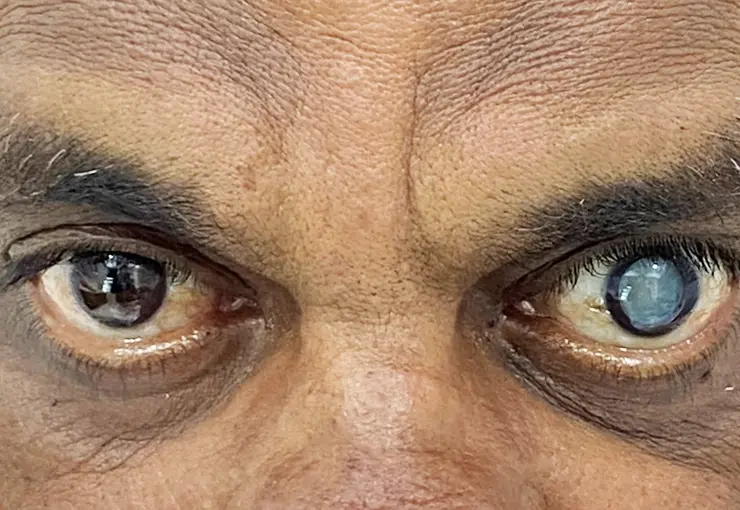Motiyabindu operation, also known as cataract surgery, is a surgical procedure performed to treat cataracts, a common eye condition characterized by the clouding of the eye’s natural lens. Cataracts can cause blurry vision, difficulty seeing in low light, and can lead to vision loss if left untreated.
During the Motiyabindu operation (cataract surgery), the cloudy natural lens of the eye is removed and replaced with an artificial lens, known as an intraocular lens (IOL).
Cataract surgery is generally considered a safe and effective procedure, and it can significantly improve a person’s vision and quality of life when cataracts are affecting their sight. If you or someone you know has been diagnosed with cataracts and is considering cataract surgery (Motiyabindu operation), it’s important to consult with an eye care specialist to discuss the best treatment options for your particular situation.

Types of Motiyabind:
Nuclear Cataracts:
- These cataracts form in the center (nucleus) of the eye’s natural lens. They are often associated with aging and can cause changes in vision, such as difficulty seeing objects up close or a temporary improvement in reading vision (known as “second sight”) before vision deteriorates further.
Cortical Cataracts:
- Cortical cataracts develop in the lens cortex, the outer part of the eye’s natural lens. They are characterized by wedge-like or spoke-like opacities that start at the edge of the lens and work their way toward the center. Cortical cataracts can cause glare and difficulties with contrast vision.
Subcapsular Cataracts:
- These cataracts form beneath the lens capsule, which is the clear, outer covering of the lens. Subcapsular cataracts tend to develop more rapidly and can have a significant impact on vision, especially in bright light conditions. They are often associated with certain risk factors, such as diabetes and the long-term use of steroids.
Common symptoms of cataracts
Cloudy or Blurred Vision: The most common symptom of cataracts is a gradual clouding or blurring of your vision. It may feel like you’re looking through a foggy or frosted window.
Reduced Night Vision: Cataracts can make it challenging to see clearly at night or in low-light conditions. You may experience increased glare from headlights or streetlights.
Sensitivity to Light: You might become more sensitive to bright lights and experience discomfort when exposed to sunlight or other strong light sources.
Halos Around Lights: Some people with cataracts see halos or rings around lights, particularly at night.
Why Choose Our Motiyabindu Surgery:
Experienced Specialists: Emphasize the expertise and experience of your ophthalmologists and surgical team. Highlight their qualifications and years of experience in performing cataract surgeries.
Advanced Technology: Mention any state-of-the-art equipment and advanced surgical techniques you use for cataract surgery. Patients often seek the latest technology for the best outcomes.
Personalized Care: Explain how your facility provides personalized care to each patient. Describe the comprehensive evaluations, individualized treatment plans, and attention to patients’ unique needs.
Patient-Focused Approach: Highlight your commitment to patient satisfaction and comfort. Mention efforts to ensure a stress-free and comfortable surgical experience.
Quick Recovery: If your hospital offers techniques like phacoemulsification or micro-incision cataract surgery, highlight how these advanced methods often lead to quicker recovery times and less discomfort.
Affordable Options: If applicable, mention any affordable pricing options, insurance coverage, or financing plans available to make cataract surgery accessible to a wider range of patients.
Positive Outcomes: Share success stories or statistics showcasing the positive outcomes and improved vision that patients can expect after cataract surgery at your facility.
The Cataract Surgery Process:
Anesthesia:
- Most cataract surgeries are performed using local anesthesia, which involves numbing the eye with eye drops or an injection around the eye. In some cases, general anesthesia may be used, especially for patients with specific medical conditions or anxiety.
Incision:
- The surgeon creates a small incision in the clear covering of the eye (cornea). Advanced techniques like phacoemulsification use a tiny incision, while traditional methods may require a larger one.
Lens Capsule Opening:
- A circular opening is made in the thin, transparent membrane that surrounds the natural lens, known as the lens capsule.
Cataract Removal:
- Using phacoemulsification or other specialized instruments, the surgeon breaks up and removes the cloudy lens (cataract) from the lens capsule. The cataract is typically removed in small pieces.
IOL Implantation:
- Once the cataract is removed, an artificial intraocular lens (IOL) is inserted through the same incision. The IOL is carefully positioned inside the lens capsule, where it remains permanently to help focus light onto the retina.
Stitch or Self-Sealing Incision:
- Depending on the type of incision and surgical technique used, the incision may be closed with a small suture or may be self-sealing, requiring no stitches.
Postoperative Care:
- After the surgery, the patient is monitored briefly in a recovery area. Eye drops may be prescribed to prevent infection and inflammation, and a protective eye shield or patch may be provided to protect the eye during the initial healing phase.
Risk Factors of cataract surgery
Glaucoma: Cataract surgery can lead to changes in eye pressure, potentially causing or worsening glaucoma in some individuals. This risk is often managed with medication or further surgery.
IOL Dislocation: In rare cases, the artificial intraocular lens (IOL) can become displaced or dislocated, requiring additional surgery to reposition it.
Vision Complications: While the goal of cataract surgery is to improve vision, some patients may experience visual disturbances like glare, halos, or decreased contrast sensitivity, particularly in low-light conditions.
Persistent Refractive Errors: After cataract surgery, some patients may still require glasses for reading or distance vision, depending on the type of IOL used and other factors.
Anesthesia Complications: Although rare, complications related to anesthesia can occur, such as allergic reactions or systemic side effects.
Underlying Medical Conditions: Patients with certain medical conditions, such as diabetes or pre-existing eye conditions, may face a higher risk of complications during or after cataract surgery.
